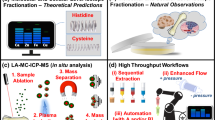Abstract
Trace metal analysis has been long regarded as one of the principle tasks in areas of chemical analysis. At the early stage of instrumental development, total concentration was assessed in a variety of samples, yielding results, among others, for environmental, biological, and clinical samples. With the power of newer analytical techniques, such as inductively coupled plasma mass spectrometry (ICP-MS), accurate quantitative results can now be obtained at ultra-trace levels not only for metals, but also for metalloids and several non-metals. Even though the importance of trace elements in many biological processes is widely accepted, the elucidation of their biological pathways, understanding specific biological functions, or possible toxicological aspects is still a challenge and a driving force to further develop analytical methodology. Over the past decades, the scientific interest has moved from total element determination to include speciation analysis, which provides quantitative information of one or more individual element species in a sample. More recently, metallomics has been introduced as a more expanded concept, in which the global role of all metal/metalloids in a given system is considered. Owing to the multi-elemental focus of metallomics research, the use of ICP-MS becomes indispensable. Furthermore, considering the biological role of metals/metalloids and the use of elements as internal or external molecular tags, epigenetics should be considered as an important emerging application for metallomics studies and approaches. Among a variety of epigenetic factors, essential nutrients, but also environmental toxins, have been shown to affect DNA methylation, modification of histone proteins, and RNA interference, all of them being implicated in cancer, cardiovascular disease, and several inherited conditions. Recent studies suggest that epigenetics may be a critical pathway by which metals produce health effects. In this Trends article, the basic epigenetic concepts are introduced, followed by the early applications of ICP-MS classified as: (i) detection of 31P as a natural element tag for DNA, (ii) analysis of DNA adducts with metal-based drugs, (iii) element species as epigenetic factors.



Similar content being viewed by others
References
Caruso JA, Klaue B, Michalke B, Rocke DM (2003) Ecotoxicol Environ Saf 56:32–44
Haraguchi H (2004) J Anal At Spectrom 19:5–14
Szpunar J (2005) Analyst 130:442–465
López-Barea J, Gómez-Ariza JL (2006) Proteomics 6:S51–S62
Prange A, Profrock D (2008) J Anal At Spectrom 23:432–459
Sutherland JE, Costa M (2003) Ann NY Acad Sci 983:151–160
Laird PW (2005) Human Mol Genetics 14:R65–R76
Johnson IT, Belshaw NJ (2008) Food Chem Toxicol 46:1346–1359
Rodenhiser D, Mann M (2006) Can Med Assoc J 174:341–348
Dueñas-Gonzalez A, Lizano M, Candelaria M, Cetina L, Arce C, Cervera E (2005) Mol Cancer 38–62
Zhang AH, Bin HH, Pan XL, Xi XG (2007) J Toxicol Environ Health A 70:970–975
Fieghl H, Elmasry K (2007) Dis Markers 23:89–96
Herzeg Z (2007) Mutagenesis 22:91–103
Ferguson LR, Karunasinghe N, Philpott M (2004) Environ Mol Mutagen 44:36–43
Salnikow K, Zhitkovich A (2008) Chem Res Toxicol 21:28–44
Vahter M (2008) BCPT (Basic Clin Pharmacol Toxicol) 102:204–211
Brouwers EEM, Tibben M, Rosing H, Schellens JHM, Beijnen JH (2008) Mass Spectrom Rev 27:67–100
Huang J, Hu X, Zhang J, Li K, Yan Y, Xu X (2006) J Pharm Biomed Anal 40:227–234
Garcia Sar D, Montes-Bayon M, Aguado Ortiz L, Blanco Gonzalez E, Sierra LM, Sanz-Medel A (2008) Anal Bioanal Chem 390:37–44
Zhou X, Sun H, Ellen TP, Chen H, Costa M (2008) Carcinogenesis 29:1831–1836
Fischer JM, Robbins SB, Al-Zoughool M, Kannamkumarath SS, Stringer SL, Larson JS, Caruso JA, Talaska G, Stambrook PJ, Stringer JR (2005) Mutat Res 588:35–46
Evans CD, LaDow K, Schumann BL, Savage RE Jr, Caruso JA, Vonderheide A, Succop P, Talaska G (2004) Carcinogenesis 25:493–497
Wrobel K, Wrobel K, Caruso JA (2002) J Anal At Spectrom 17:1048–1054
Sanz-Medel A, Montes Bayon M, Fernandez de la Campa MR, Ruiz Encinar J, Bettmer J (2008) Anal Bioanal Chem 390:3–16
Siethoff C, Feldmann I, Jakubowski N, Linscheid M (1999) J Mass Spectrom 34:421–426
Edler M, Jakubowski N, Linscheid M (2006) J Mass Spectrom 41:507–516
Profrock D, Leonhard P, Prange A (2003) J Anal At Spectrom 18:708–713
Garcia Sar D, Montes Bayon M, Blanco-Gonzalez E, Sanz-Medel A (2008) J Anal At Spectrom 21:861–868
Heffeter P, Jungwirth U, Jakupec M, Hartinger C, Galanski M, Elbling L, Micksche M, Keppler B, Berger W (2008) Drug Resist Update 11:1–16
Chekhun VF, Lukyanova NY, Kovalchuk O, Tryndyak VP, Pogribny IP (2007) Mol Cancer Therap 6:1089–1098
Gronbaek K, Hother C, Jones AP (2007) APMIS 115:1039–1059
Hartinger CG, Keppler BK (2007) Electrophoresis 28:3436–3446
Timerbaev AR, Hartinger CG, Aleksenko SS, Keppler BK (2006) Chem Rev 106:2224–2248
Francesconi KA, Kuehnelt D (2004) Analyst 129:373–395
Dopp E, Hartmann LM, Florea AM, von Recklinghausen U, Pieper R, Shokouhi B, Rettenmeier AW, Hirner AV, Obe G (2004) Toxicol Appl Pharmacol 20:156–165
Rabieh S, Hirner AV, Matschullat J (2008) J Anal At Spectrom 23:544–549
Yathavakilla SKV, Fricke M, Creed PA, Heitkemper DT, Shockey NV, Schwegel C, Caruso JA, Creed JT (2008) Anal Chem 80:775–782
Kajander EO, Pajula RL, Harvima RJ, Eloranta TO (1989) Anal Biochem 179:396–400
Author information
Authors and Affiliations
Corresponding author
Rights and permissions
About this article
Cite this article
Wrobel, K., Wrobel, K. & Caruso, J.A. Epigenetics: an important challenge for ICP-MS in metallomics studies. Anal Bioanal Chem 393, 481–486 (2009). https://doi.org/10.1007/s00216-008-2472-3
Received:
Revised:
Accepted:
Published:
Issue Date:
DOI: https://doi.org/10.1007/s00216-008-2472-3




